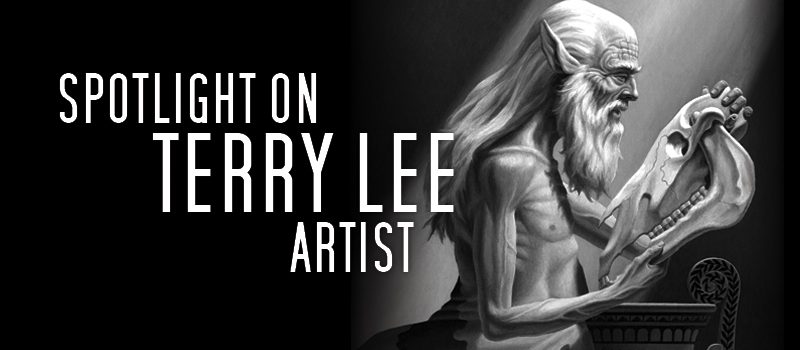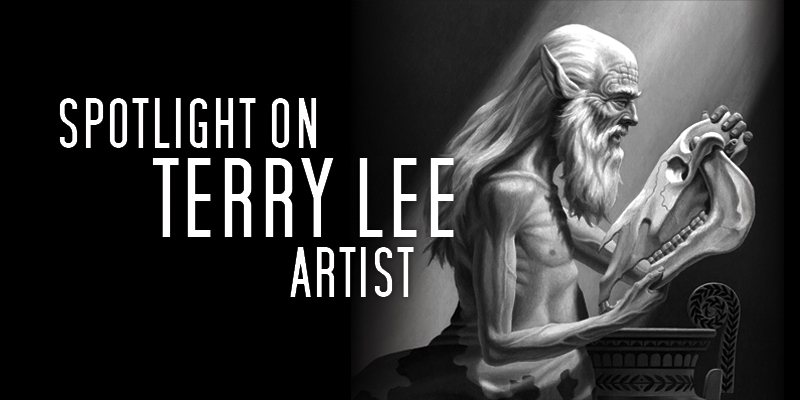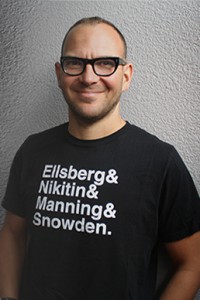Spotlight on: Terry Lee, Artist
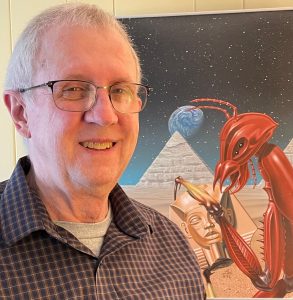 TERRY LEE is a science fiction artist and former font designer for the Hallmark Co. in the region of Kansas City, Kansas. He is known for numerous covers and interior art pieces for science fiction novels and magazines, beginning in the late ’70s through the mid ’90s. He won the Chesley Award in 1988. Interview conducted by author Eric J. Hildeman.
TERRY LEE is a science fiction artist and former font designer for the Hallmark Co. in the region of Kansas City, Kansas. He is known for numerous covers and interior art pieces for science fiction novels and magazines, beginning in the late ’70s through the mid ’90s. He won the Chesley Award in 1988. Interview conducted by author Eric J. Hildeman.
Eric J. Hildeman: When did you first decide to pursue science fiction art professionally?
Terry Lee: Professionally, let’s see, actually I got degrees in art, psychology, and philosophy at KU. And I just wanted to be an illustrator in general. So probably I’d say about, ’74, ’75. I teamed up with John Kessel to do a comic strip and that was the first thing I did science-fiction-wise.
EH: You and John Kessel collaborated on that Crosswhen comic strip in, I believe it was, Galileo Magazine in the ’70s. You also did an illustration for Kessel’s story, ‘‘The Silver Man’’, for that same magazine. How did all that come about?
TL: Well, his wife and my wife worked together as teachers in a specialty school, and I had started just playing around with trying to do a comic strip, and I was doing spaceship drawings working on a pen-and-ink technique which was a combination of cross-hatch and stipple and outline, and anyway, my wife was talking to his wife, and he seemed interested in talking to me, so I got together and he offered to write, and then I would do the drawings. He actually helped us get in print first. He needed a contact and came up with a contact at Galileo magazine. I wouldn’t have known where to start at all. He knew the business.
EH: The Hallmark corporation in Kansas City, where you worked, that seems to be a hub of science fiction based on everything I’ve found out, not only for your career, but many others. Pat Cadigan also worked there, Arnie Fenner and his wife, Cathy, who established the Spectrum Awards and the Spectrum series of art books had connections there. It’s almost like Hallmark had its own science fiction club. Was that the case?
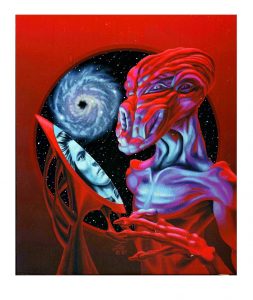 TL: That was the case. We didn’t have a club, but yeah, it was like a little nexus there. That’s in fact where I met Cathy and Arnie. We worked in the same department – the literary department. We worked together for several years. A lot of the illustrations I just did pro bono, for free, just because I liked doing it. And I did covers and book illustrations for Arnie when he was doing his book business. Then I was a judge for one of the Spectrums – Spectrum 4, I think it was.
TL: That was the case. We didn’t have a club, but yeah, it was like a little nexus there. That’s in fact where I met Cathy and Arnie. We worked in the same department – the literary department. We worked together for several years. A lot of the illustrations I just did pro bono, for free, just because I liked doing it. And I did covers and book illustrations for Arnie when he was doing his book business. Then I was a judge for one of the Spectrums – Spectrum 4, I think it was.
EH: How did you come to be the artist who did the illustrations for Harlan Ellison’s screenplay of ‘‘I, Robot: The Movie’’, published in Asimov’s in 1987? [Interviewer’s Note: This screenplay had nothing to do with the 2004 movie starring Will Smith.]
TL: That’s kind of a two-part thing. I submitted some artwork to Asimov’s when I was submitting to several magazines – got turned down all the time – but Asimov’s was interested and gave me a shot and I had pretty good luck with them. Arnie was really good friends with Harlan Ellison, I mean, he did all kinds of work for Harlan and they were great friends. So, he lined me up to do a couple of jobs for Harlan, and I got to know Harlan a little bit. When I heard about the project at Asimov’s, I called them up and I begged and pleaded. I said, just, ‘‘Please, just let me illustrate that!’’ They contacted Harlan, and Harlan was all for it. He said he liked the way I did people’s faces.
EH: You did the cover for the January 1988 issue of Amazing Stories, and that was the cover that won you the Chesley Award. Did you know when you finished that you’d done something that would be so noteworthy?
TL: Eh, no. I had no idea whatsoever. But I put a lot into that. It was probably one of my best pieces.
EH: Stylistically, your work is pretty recognizable with smooth lines and distinctive shading. Who were your artistic influences when you were learning your craft?
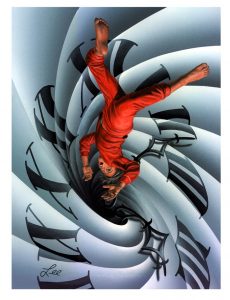 TL: When I was first painting, like from the pen-and-ink standpoint, I liked the stylings of two artists. One was Rick Griffin, who was a regular contributor to Zap Comix and, you know, he was kind of a religious guy. Robert Crumb is the most politically incorrect artist I think there ever was. So, I think his stuff’s hard to look at. But a terrific artist, very creative. So as far as pen and ink, I like their stuff. And then, for painting, I use sort of an egg tempera technique for the shading…. I think Andrew Wyatt is a good example of that, with egg tempore, except I did it with acrylic instead. It’s the same technique. And then Don Ivan Punchatz, I’m a huge fan of his, I think he did about five or six… he did a lot of works for Arnie. And he also has a very similar technique, like with Italian brush-strokes. It’s very slow – I think one of the reasons I had trouble making a living as a science fiction artist, I mean, I needed a day job. But I liked the result.
TL: When I was first painting, like from the pen-and-ink standpoint, I liked the stylings of two artists. One was Rick Griffin, who was a regular contributor to Zap Comix and, you know, he was kind of a religious guy. Robert Crumb is the most politically incorrect artist I think there ever was. So, I think his stuff’s hard to look at. But a terrific artist, very creative. So as far as pen and ink, I like their stuff. And then, for painting, I use sort of an egg tempera technique for the shading…. I think Andrew Wyatt is a good example of that, with egg tempore, except I did it with acrylic instead. It’s the same technique. And then Don Ivan Punchatz, I’m a huge fan of his, I think he did about five or six… he did a lot of works for Arnie. And he also has a very similar technique, like with Italian brush-strokes. It’s very slow – I think one of the reasons I had trouble making a living as a science fiction artist, I mean, I needed a day job. But I liked the result.
EH: Is that your preferred medium when you do artwork?
TL: It used to be. I’m getting pretty old now, pretty long in the tooth. I don’t have nearly the hand-control I used to. It took a lot of hand-control to do that kind of stuff. Now everything’s done digitally or on a tablet.
EH: You are credited with some interior work for Spectrum 1 and Spectrum 2 which was published back in the ’90s, and you said you were a judge for Spectrum 4. Did you do anything relating to science fiction or fantasy art after that?
TL: Mostly I kind of transitioned at that time. I transitioned into graphic design at Hallmark, which started as a day-job and kind of became more of a career, and started specializing in typography and type-design. Also, they asked for volunteers to do IT, they didn’t have an IT department. So, I volunteered for that. It was supposed to be a six-month assignment, it turned into six years. That was great, I learned a hell of a lot about computers. And then I went back on the boards. I did a little cartooning for Hallmark and some additional graphic design.
Eric J. Hildeman is an accountant, story writer and blogger living in Milwaukee, WI who founded the Milwaukee Science Fiction League in early 2021 (milwaukeescifi.com). He’s had stories published in various anthologies and recently won Honorable Mention in the L. Ron Hubbard Writers of the Future Contest.
 While you are here, please take a moment to support Locus with a one-time or recurring donation. We rely on reader donations to keep the magazine and site going, and would like to keep the site paywall free, but WE NEED YOUR FINANCIAL SUPPORT to continue quality coverage of the science fiction and fantasy field.
While you are here, please take a moment to support Locus with a one-time or recurring donation. We rely on reader donations to keep the magazine and site going, and would like to keep the site paywall free, but WE NEED YOUR FINANCIAL SUPPORT to continue quality coverage of the science fiction and fantasy field.
©Locus Magazine. Copyrighted material may not be republished without permission of LSFF.


